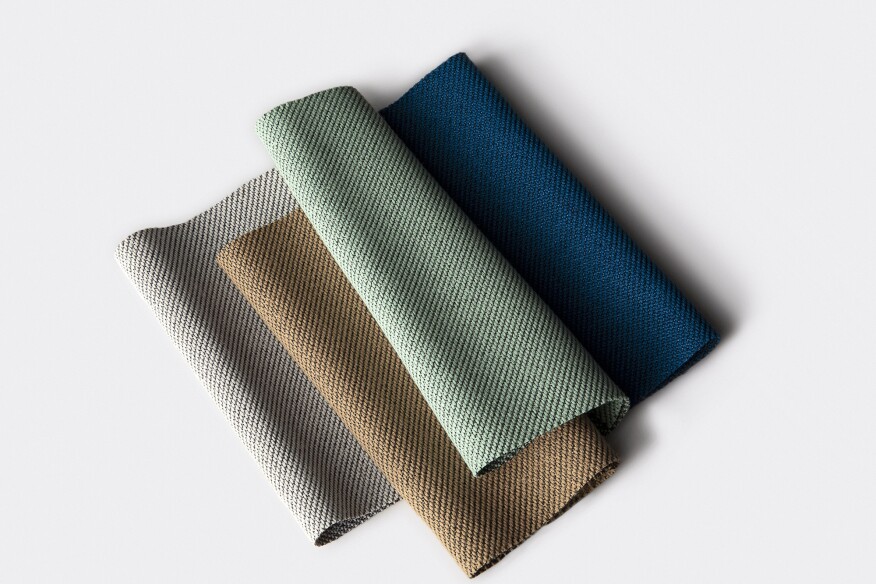
Textiles are ubiquitous in the designed environment, and demand for new fabrics continues to grow. The global textile market is estimated to be worth more than $1.6 trillion and is predicted to increase 7.6% annually until 2030. Unfortunately, this growth has resulted in burgeoning material waste streams. According to the U.S. Environmental Protection Agency, more than 17 million tons—or 112 pounds per person—of textiles are disposed of yearly. Fewer than 20% of fabrics are collected at the end of their useful lives for reuse or recycling.
Suzanne Tick is on a crusade to transform this bleak reality. The award-winning, New York–based contract textile designer and weaver is reshaping textiles into cradle-to-cradle materials that are as innovative environmentally as they are in function and aesthetics. After serving as creative director for KnollTextiles for more than a decade, Tick transitioned into the same role at Luum Textiles in 2013, with a fundamental focus on sustainability. She has since developed technical fabrics that represent new achievements in material environmental performance—with the potential to transform the textile industry.

An example is Tilt Shift (2019), and the reimagined Tilt Shift Redux (2022), made predominantly from post-consumer recycled polyester waste. A long proponent of working with natural materials like wool, Tick was motivated by the fact that a significant percentage of today’s textiles—including 60% of apparel—are petroleum-based polyester (otherwise known as plastic). “We wanted to manifest as much recycled content as possible and work with manufacturers who would work with us,” she explains.
Luum began to develop its own fibers out of recycled content alongside other various manufacturers. When a woman-owned European textile mill with 250 years of experience in garment recycling contacted Luum, Tick jumped at the chance to collaborate. Discarded clothing represents a significant portion of textile waste, comprising some 92 million tons annually worldwide; thus, garment waste has become an ideal material source for Tilt Shift and other fabrics.

This new product achievement led to the even more ambitious circular economy goal of biodegradability. In 2021, Luum created Grid State and Ecotone, textiles that are 100% recycled, biodegradable polyester content—an industry-first, according to the brand. An additive encourages and accelerates microbial degradation of the textile at the end of its useful life, ultimately converting the polyester to CO2 and water. Because the biodegradation process only occurs anaerobically (without oxygen), such as in a composting plant or a landfill, material durability is ensured until the textile is discarded. In fact, all of Luum’s biodegradable textiles (Grid State, Ecotone, Biotope, and Intraweb) are considered high-performance fabrics, enduring 100,000 double rubs (an industry measure of durability).
Biodegradability imparts polymer textiles with characteristics typically associated with natural fibers. “The mills asked, ‘What do you want?’ I want it to be like wool—I want it to biodegrade,” Tick recalls. Intraweb, a 100% recycled and biodegradable textile Luum introduced this year, exhibits a microstructure similar to wool—with hollow cores created by the addition of the biocatalyst. Remarkably, the textile also mirrors wool’s decay timespan, as each material takes 3.5 years to deteriorate completely. Moreover, as a textured fabric like Luum’s Biotope demonstrates, the similarity to wool also extends to the overall structure and tactility of the end product.

For Tick, once such a high level of environmental performance is demonstrated while meeting similarly rigorous aesthetic, durability, and price goals, there is no turning back. “I'm not interested in working with virgin polyester anymore,” she says. “I don’t want this world to turn into mounds of polyester fabric that don’t biodegrade.” Luum’s success with sustainable textiles is evident in both the marketplace and supplier interest. “The mills we are working with have seen huge growth from us,” Tick. says “We’re getting calls now from around the world from manufacturers who are leading in sustainability.”
So, is this a sign of an industry turnaround? Not quite. Tick acknowledges that Luum’s medium size allows the company to prioritize a focused product range—as opposed to the vast collections that larger corporations maintain, and which are comprised primarily of established textile feedstocks. That said, the design community has a tremendous influence and can motivate the industry as a whole to improve. Luum has attained new heights in sustainable material performance—just the kind of inspiration the design community can get behind.
“People want to do the right thing. The architecture and design community need to demand this from their suppliers,” Tick says. “Where our attention goes, energy flows.”
The views and conclusions from this author are not necessarily those of ARCHITECT magazine or of The American Institute of Architects.
Read more: The latest from columnist Blaine Brownell, FAIA, includes looks at emerging carbon capture and storage technologies, the blue economy, and AI's impact on supply chain management.
















